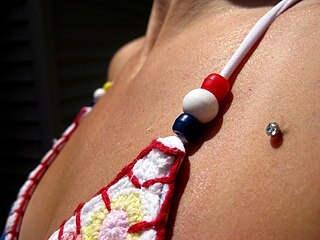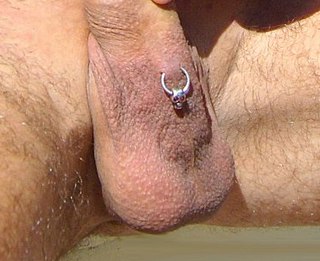
The Prince Albert (PA) is one of the most common male genital piercings. The PA is "a ring-style piercing that extends along the underside of the glans from the urethral opening to where the glans meets the shaft of the penis." The related "reverse Prince Albert piercing" enters through the urethra and exits through a hole pierced in the top of the glans.

A lip piercing is a type of body piercing that penetrates the lips or the area surrounding the lips, which can be pierced in a variety of ways.

Body modification is the deliberate altering of the human anatomy or human physical appearance. It is often done for aesthetics, sexual enhancement, rites of passage, religious beliefs, to display group membership or affiliation, in remembrance of lived experience, traditional symbolism such as axis mundi and mythology, to create body art, for shock value, and as self-expression, among other reasons. In its broadest definition it includes plastic surgery, socially acceptable decoration, and religious rites of passage, as well as the modern primitive movement.

Nose piercing is the piercing of the skin or cartilage which forms any part of the nose, normally for the purpose of wearing jewelry, called a nose-jewel. Among the different varieties of nose piercings, the nostril piercing is the most common. Nose piercing is the third most common variety of piercing after earlobe piercing and tongue piercing.

A tongue piercing is a body piercing usually done directly through the center of the tongue. Since its decline in popularity around 2011, it has seen a recent upsurge making it now the second most popular piercing amongst young women aged 18-25 in 2019. It remains unpopular amongst men. Standard tongue piercings, or one hole in the center of the tongue, is the most common and safest way to have the tongue pierced.

The frenulum of labia minora is a frenulum where the labia minora meet posteriorly.

A frenum piercing is a type of body piercing located on the underside of the shaft of the penis. A series of parallel frenum piercings is known as a frenum ladder. A frenum ladder may be extended to include lorum piercings, hafada piercings and guiche piercings.

Transdermal implants are a form of body modification used both in a medical and aesthetic context. In either case, they consist of an object placed partially below and partially above the skin, thus transdermal. The skin around it generally heals as if it were a piercing.

A labret is one form of body piercing. Taken literally, it is any type of adornment that is attached to the lip (labrum). However, the term usually refers to a piercing that is below the bottom lip, above the chin. It is sometimes referred to as a "tongue pillar" or a "soul patch piercing."
A transscrotal piercing is a body piercing that travels through the scrotum from front to back, or from side to side. It is a high risk procedure.

A lorum is a male genital piercing, placed horizontally on the underside of the penis at its base, where the penis meets the scrotum. The word "lorum" is a portmanteau of the words "low" and "frenum", so named because it is essentially a very low-placed frenum piercing.
Scalpelling is a body art procedure similar to body piercing for the creation of decorative perforations through the skin and other body tissue, and is most commonly used as a replacement for or enhancement of ear piercing. Whereas piercing is typically performed with a hollow piercing needle or an ear piercing instrument, scalpelling is performed by using a scalpel to cut a slit into the skin. Unlike dermal punching, no flesh is removed. The technique can immediately produce holes with a larger diameter than can be achieved by piercing. This is a more rapid means of accommodating larger gauge jewellery than stretching, a technique whereby piercings are enlarged by inserting gradually larger jewellery. Scalpelling is performed to quickly achieve a large-gauge piercing, when scar tissue is preventing further stretching, if tissue has thinned to the point where further stretching could cause it to break, or to combine two closely placed piercings into one hole.
Stretching, in the context of body piercing, is the deliberate expansion of a healed piercing for the purpose of wearing certain types of jewelry. Ear piercings are the most commonly stretched piercings, with nasal septum piercings, tongue piercings and lip piercings/lip plates following close behind. While all piercings can be stretched to some degree, cartilage piercings are usually more difficult to stretch and more likely to form hypertrophic scars if stretched quickly. Dermal punching is generally the preferred method for accommodating larger jewelry in cartilage piercings.

A guiche piercing is a body piercing on the perineum. Guiche piercings are much more common in men than in women. Although a guiche normally runs perpendicular to the direction of the penis, lateral placements are possible. A series of guiche piercings in parallel to the direction of the penis is called a guiche ladder, and might commonly be seen as an extension of a frenum ladder.

Labia piercings are one type of female genital piercing. This piercing can be placed either through the labia minora or the labia majora. They are one of the simpler and more common genital piercings performed on women, and are often pierced in symmetrical pairs. Like all genital piercings, depending on jewellery and placement, they may provide additional stimulation to one or both partners during sexual intercourse.

A plug, in the context of body modification, is a short, cylindrical piece of jewelry commonly worn in larger-gauge body piercings. Modern western plugs are also called flesh tunnels. Because of their size—which is often substantially thicker than a standard metal earring—plugs can be made out of almost any material. Acrylic glass, metal, wood, bone, stone, horn, glass, silicone or porcelain are all potential plug materials.
Labia stretching, also referred to as labia elongation or labia pulling, is the act of lengthening the labia minora through manual manipulation (pulling) or physical equipment. It is a familial cultural practice in parts of Eastern and Southern Africa, and a body modification practice elsewhere. It is performed for sexual enhancement for the benefit of both partners, aesthetics, symmetry and gratification.

Body piercing, which is a form of body modification, is the practice of puncturing or cutting a part of the human body, creating an opening in which jewelry may be worn, or where an implant could be inserted. The word piercing can refer to the act or practice of body piercing, or to an opening in the body created by this act or practice. It can also, by metonymy, refer to the resulting decoration, or to the decorative jewelry used. Contrary to popular belief, that piercing is related to visual jewelry only, piercing implants alter body and/or skin profile and appearance. Although the history of body piercing is obscured by popular misinformation and by a lack of scholarly reference, ample evidence exists to document that it has been practiced in various forms by both sexes since ancient times throughout the world.
Body jewelry sizes express the thickness of an item of body jewelry, using one of several possible systems.













